#agile UX
Explore tagged Tumblr posts
Text

How to Balance Fixing Performance Issues and Adding New Features in Web Applications?
In today’s digital landscape, web applications are essential for business operations, marketing, and consumer involvement. As organizations expand and consumer expectations rise, development teams are frequently confronted with the difficult task of balancing two key priorities: addressing performance issues and introducing new features.
While boosting performance improves the user experience and increases efficiency, new features are required to remain competitive and meet market demands. Prioritizing one over the other, on the other hand, might have negative consequences—performance concerns can lead to a poor user experience while failing to innovate can result in a competitive disadvantage.
This blog delves into how to balance improving performance and introducing new features to web apps, allowing firms to satisfy technical and market demands efficiently.
Why Balancing Performance and New Features Is Crucial
A web application‘s success depends on both its performance and its features. However, relying entirely on one might result in imbalances that impair both user happiness and business progress.
Performance:Performance is an important component that directly influences user retention and happiness. Users can become frustrated and leave if the application has slow loading times, crashes, or problems. Ensuring that your web application runs smoothly is essential since 53% of mobile consumers would quit a site that takes more than three seconds to load.
New Features:On the other hand, constantly adding new features keeps users interested and promotes your company as innovative. New features generate growth by attracting new consumers and retaining existing ones who want to experience the most recent changes.
The dilemma is deciding when to prioritize bug fixes over new feature development. A poor balance can harm both performance and innovation, resulting in a subpar user experience and stagnation.
Common Performance Issues in Web Applications
Before balancing performance and features, it’s important to understand the common performance issues that web applications face:
Slow Load Times: Slow pages lead to higher bounce rates and lost revenue.
Server Downtime: Frequent server outages impact accessibility and trust.
Poor Mobile Optimization: A significant portion of web traffic comes from mobile devices and apps that aren’t optimized for mobile fail to reach their potential.
Security Vulnerabilities: Data breaches and security flaws harm credibility and user trust.
Bugs and Glitches: Software bugs lead to poor user experiences, especially if they cause the app to crash or become unresponsive.
Strategic Approaches to Fixing Performance Issues
When performance issues develop, they must be handled immediately to guarantee that the online application functions properly. Here are techniques for improving performance without delaying new feature development:
Prioritize Critical Issues:Tackle performance issues that have the most significant impact first, such as slow loading times or security vulnerabilities. Use analytics to identify bottlenecks and determine which areas require urgent attention.
Use a Continuous Improvement Process:Continuously monitor and optimize the application’s performance. With tools like Google PageSpeed Insights, you can track performance metrics and make incremental improvements without major overhauls.
Optimize Database Queries:Slow database queries are one of the leading causes of web app performance issues. Optimize queries and ensure that the database is indexed properly for faster access and retrieval of data.
Reduce HTTP Requests:The more requests a page makes to the server, the slower it loads. Minimize requests by reducing file sizes, combining CSS and JavaScript files, and utilizing caching.
5. Leverage Caching and CDNs: Use caching strategies and Content Delivery Networks (CDNs) to deliver content quickly to users by storing files in multiple locations globally.
Why Adding New Features is Essential for Growth
In the rapidly changing digital environment, businesses must continually innovate to stay relevant. Adding new features is key to maintaining a competitive edge and enhancing user engagement. Here’s why:
User Expectations:Today’s consumers expect personalized experiences and constant innovation. Failure to add new features can lead to customer churn, as users may feel your web application no longer meets their needs.
Market Differentiation:Introducing new features allows your application to stand out in the marketplace. Unique functionalities can set your app apart from competitors, attracting new users and increasing customer loyalty.
Increased Revenue Opportunities:New features can lead to additional revenue streams. For example, adding premium features or new integrations can boost the app’s value and lead to increased sales or subscription rates.
4. Feedback-Driven Innovation: New features are often driven by user feedback. By continuously developing and adding features, you create a feedback loop that improves the overall user experience and fosters customer satisfaction.
Read More: https://8techlabs.com/how-to-balance-fixing-performance-issues-and-adding-new-features-in-web-applications-to-meet-market-demands-and-enhance-user-experience/
#8 Tech Labs#custom software development#custom software development agency#custom software development company#software development company#mobile app development software#bespoke software development company#bespoke software development#nearshore development#software development services#software development#Website performance testing tools#Speed optimization for web apps#Mobile-first web app optimization#Code minification and lazy loading#Database indexing and query optimization#Agile vs Waterfall in feature development#Feature flagging in web development#CI/CD pipelines for web applications#API performance optimization#Serverless computing for better performance#Core Web Vitals optimization techniques#First Contentful Paint (FCP) improvement#Reducing Time to First Byte (TTFB)#Impact of site speed on conversion rates#How to reduce JavaScript execution time#Web application performance optimization#Fixing performance issues in web apps#Web app performance vs new features#Website speed optimization for better UX
0 notes
Text
Website and Product Design: Where Development Meets Strategy
🚀 Website & product design aren’t separate; they’re partners in the SDLC. From planning to deployment, seamless UX and strategy drive digital success. 🔥💡 #WebDesign #ProductDesign #UX #SDLC #DigitalStrategy #Innovation #Technology #Management #WebDev
In modern development, website and product design aren’t just complementary; they’re inseparable. Both are critical to delivering a seamless user experience, ensuring that aesthetics align with functionality and that business goals translate into intuitive digital interactions. Where They Intersect in the SDLC Throughout the Software Development Life Cycle (SDLC), website and product design play…
0 notes
Text
#BugHerd#Website feedback tool#Project management tool#Web development process#Streamline web development#Bug tracking tool#Collaboration tool#Agile development#Web design feedback#User experience (UX)#User interface (UI)#Developer tools#Design feedback#Team collaboration#Productivity tools#Efficient workflow#Quality assurance (QA)
0 notes
Text
The Importance of User Interface (UI) and User Experience (UX) Design in App Development

Introduction
In the fast-paced world of digital solutions, the collaboration between User Interface (UI) and User Experience (UX) design is crucial for the success of mobile app development services and other digital platforms. Effective UI/UX design not only improves usability but also boosts user satisfaction, driving higher engagement and retention rates.
Why UI/UX Design Matters in App Development:
In the competitive landscape of website and mobile app development, along with cloud services, UI/UX design stands as the foundation for creating impactful digital experiences. Here’s why it’s essential:
Enhancing User Engagement and Satisfaction: UI design focuses on creating visually appealing interfaces that are easy to navigate. Meanwhile, UX design ensures seamless and enjoyable interactions within the app, leading to overall user satisfaction and loyalty.
Driving Business Success: Investing in professional UI/UX design services not only enhances app usability but also boosts conversion rates and profitability. A well-designed interface can significantly increase user adoption and brand loyalty.
Standing Out in a Crowded Market: In a saturated market of mobile app development services, distinguishing your app is critical. Exceptional UI/UX design sets your app apart by delivering a memorable user experience, which can result in positive reviews and referrals.
Conclusion
UI/UX design plays a pivotal role in app development across mobile, web, and cloud platforms. By prioritizing user-centric design principles, businesses can foster engagement, drive growth, and gain a competitive advantage in today’s digital landscape. Embracing UI/UX design ensures that digital products not only meet but exceed user expectations, paving the way for sustained success and long-term relationships.
#mobile app development services#mobile UI/UX design#mobile app prototyping#agile mobile app development#mobile app maintenance and support#mobile app marketing and strategy
1 note
·
View note
Text
0 notes
Text
Lucifer :
the rebellious archangel

🖤
Before we begin :
No, he's not the red devil with horns and a pitchfork.
No, he's not the guy who haunts your dreams after watching "Supernatural."
And no, he doesn't spend his days torturing souls while listening to black metal (well... not all the time).
Lucifer is, above all, a symbol. A big symbol. And a fucking clash with authority.
🖤
Back to the Bible & Co. (even if you're an atheist, stay, it's stylish) :

Lucifer, literally "light bearer" (lux = light, ferre = to carry), was originally an angel. And not just any angel : High-ranking seraph, archetype of the heavenly darling, angel of light, right-hand man of God. It rocks. 🌟
God: "You see Michael? That kid is a heavenly bombshell. He shines brighter than the sun. Even his ego has golden highlights."
Michael : hum hum... 😑
Lucifer (fixing his hair in front of a star-studded mirror): "I'm the drama, the light, and a little more stylish than the others. Just a little." 😏🪮
But... it wasn't enough.
He wanted more.
And on his own way...
🖤
Fallen angel
God created man in his image, capable of free will, but he still has the obligation to submit to God. Lucifer absolutely disagreed with this. What's the point of submitting if you're free ? No sens..
🖤
[Scene: Celestial office. Cloud ceiling, gold walls. Lucifer, the ultra-stylish archangel, enters God's office.]
God (behind a desk of light, drinking a starry infusion):
Ah, Lucifer, my darling! The brightest, the most handsome, the most... worried? 🤨
Lucifer (in a white suit, impeccable wings, the look of a rebellious CEO):
Can we talk, boss? Because I looked at the new plans... and frankly, there's a bug.
God (intrigued):
A bug? I updated the system ages ago... 🤨
Lucifer:
You give humans free will—like, they can choose—but they have to obey you? That's like saying "you can do whatever you want" and then sticking a sign up saying "beware, mortal sin if you disobey me." That's not very UX-friendly. 🤨
God (calmly):
True love comes from choice. 😌
Lucifer (darkly):
No, it comes from mutual respect. And I'm not respecting that plan right now. 😠
🖤
The driving force that caused Lucifer to dictate “his truth” was his pride. Lucifer was created perfect and beautiful, but it went to his head ( Ezekiel 28:17 ). He doesn't want to remain an executor. He wants to manage. Rewrite the system. Better than God...
He also influenced a third of the holy congregation by questioning God’s law :
🖤
[Scene: Angel union meeting in a corner of the Milky Way]
Lucifer (standing on a cloud):
Brothers and Sisters, why do we blindly obey? Why remain eternally in the shadow of Someone who tolerates no contradiction?! 😠
Angel #1 (shy):
But... it's God. He created everything, right? 😳
Lucifer (inspired serpent smile):
And that's exactly it. I propose we innovate. New throne, new hierarchy. Celestial transversality.
Divine agility, baby. 😏
Angel #2:
You want to overthrow God? 😨
Lucifer:
I want... another version of heaven. What if God doesn't want to share? Then let Him go.
Spoiler: 1/3 of the angels like, 2/3 freak out, God clicks "ban user."
[BOOM: Lucifer is deposed, becoming public enemy number one. God blocks his Heaven badge. Lucifer crashes, but keeps his style.]
🖤
Prince of Hell

God, without removing the manipulation and coercion of his creature, tried to correct Lucifer, who know exactly that by rejecting the law, he was rejecting God himself (the giver of life, the sustainer and the law personified). Rejecting God is the same as rejecting that which gives life.
Lucifer was cast out of heaven along with his accomplices, and his name and title were stripped from him. He became Satan : the Adversary, the Fallen Angel.
So Lucifer create his own Kingdom under the earth : Hell 🔥... And he became King of Hell 🔥
🖤
[Scene: Lucifer is literally expelled from Heaven. He lands in a molten nothingness]
Lucifer (scraping the floor, his hair slightly singed):
Okay. Cast out, punished, exiled. But not destroyed. 😃
[He looks around. It's dark. He snaps his fingers. A throne rises from the ashes.]
Lucifer:
Let's redecorate. Hell isn't a punishment. It's an alternative. 😏
Demon Intern (shy):
Are you... uh... the new boss? 😳
Lucifer:
I prefer the term CEO of lost souls. We're going to modernize a bit, get rid of the chains, add some cushions. Hot, sure, but comfortable. 😏
Demon Intern:
And your plan? 🤨
Lucifer:
Make Hell an alternative, not a punishment. God has his laws? I have my flames. And they welcome everyone. 😏
🖤
Why Church don't like him ?
In Christianity, Lucifer, having become Satan, embodies total disobedience.
He is the adversary, the tempter, the father of lies. He doesn't just want you to sin, he wants you to deny God himself, to die spiritually.
He knows what he's doing. He's not just jealous. He wants to tear humanity away from the light, to unmoor it from life.
Do you know the original sin? That moment when Eve bites into the apple (thanks, Lilith, for warming things up) and Adam stupidly follows? That's the move Lucifer prepared like a magic trick:
🖤

[Scene: Garden of Eden. Adam is picking flowers. Eve is watching the butterflies. A very stylish snake coils around the forbidden tree.]
Lucifer (inside the snake):
Hello, beautiful. You know you're beautiful when you doubt ? 😏
Eve:
God said not to eat that. 🫢
Lucifer:
Yes, but... do you ever wonder why? He hides things from you. Knowledge. Power. Autonomy. 😈
Eve:
But... if I eat, will I die? 😦
Lucifer (gentle smile):
No. You'll see clearly. 😈
[Bite. Boom. Fall. Humanity rebooted with "original sin" glitch. Lucifer raises his arms.]
Lucifer:
First blow landed. The war begins. 😈
He represents :
The enemy.
The liar.
The tempter.
The destroyer.
The one who brought evil into the world.
But above all : the proud one.
The one who wanted to be in God's place.
Not equal. Superior.
And who lost everything.
🖤
But... In Luciferianism :

Lucifer is not "Satan."
He is:
👑 The light (Lux ferre = bearer of light)
👑 The symbol of enlightened rebellion
👑 The archetype of liberating knowledge
👑 The enemy of dogma and conformity
👑 The energy of transformation and questioning
Luciferians = those who seek the truth even if it hurts, even if it calls everything into question.
Satanists = more varied (theists, symbolic, LaVey, etc.), but often against religious hypocrisy.
🖤
Who is Lucifer for me :
A symbol. A presence. A breath of fire.
Lucifer is the inner voice that says:
"No. It's not right."
"No. I won't submit."
"No. I won't bow down."
It's the cold stare in the face of absurd orders perceived as legitimate.
The rejection of a power that demands obedience without respect.
It's not a call to chaos for chaos' sake.
It's the call to create something else, even if it's painful.
He is a protector. Not the Devil. Not the Liar. The one who gives us the voice to love and choose ourselves. And not fear someone else.

2 notes
·
View notes
Text
Flutter Developers for Hire: Build Better Apps, Faster
In the fast-paced mobile world, speed and scalability matter. That’s why more businesses are turning to Flutter developers for hire to get their apps to market quickly—without sacrificing quality.
Flutter, Google’s open-source framework, enables developers to build natively compiled apps for mobile, web, and desktop—all from a single codebase. But to unlock its full potential, you need the right talent. That’s where Flutternest comes in.
Our team makes it easy to hire Flutter developers who are not only technically sound but also deeply collaborative. From UI/UX design to backend integration and post-launch support, our developers work as an extension of your team.
Whether you’re a startup or an enterprise, having skilled Flutter developers for hire can accelerate your development process and reduce costs. Plus, Flutter’s hot reload feature ensures faster iterations, helping you stay agile and competitive.
Need a partner who gets Flutter and gets your goals? Flutternest connects you with top-tier developers ready to build sleek, scalable, and high-performing applications.
2 notes
·
View notes
Text
Best Mobile App Development Company in Jaipur | VolanSoft
Top Mobile App Development Companies in Jaipur: A Comprehensive Guide for 2024
In today's digital age, finding the right mobile app development company in Jaipur can make all the difference in turning your business idea into a successful digital reality. As someone who has closely worked with Jaipur's tech ecosystem for years, I'm excited to share insights about the leading mobile app development companies that are shaping our city's digital landscape.

Jaipur, often known for its rich heritage, has emerged as a prominent tech hub in India. The Pink City now houses several top-tier mobile app development companies that deliver world-class solutions. Let's explore the best players in this space who are helping businesses transform digitally.
VolanSoft Technologies has consistently ranked among the top mobile app development companies in Jaipur. Their portfolio showcases a diverse range of successful projects across industries. What sets them apart is their comprehensive approach to app development, combining technical expertise with deep understanding of business needs. They excel in both Android and iOS app development, making them a versatile choice for businesses of all sizes.
The mobile app development landscape in Jaipur has evolved significantly, with companies offering specialized services in React native app development, cross-platform solutions, and innovative UI/UX design. These companies bring together experienced developers who understand both local market needs and global tech standards.
When choosing a mobile app development company in Jaipur, several factors deserve attention. First, look at their portfolio – it speaks volumes about their expertise and industry experience. Second, consider their development approach. The best companies offer end-to-end services, from concept development to post-launch support. Third, evaluate their technical expertise across platforms – whether they excel in Android app development, iOS app development, or both.
What makes Jaipur's app development companies unique is their blend of cost-effectiveness and quality. Unlike their counterparts in metro cities, these companies offer competitive rates without compromising on quality. They understand local business dynamics while maintaining international development standards.
The success of any mobile app largely depends on the development team's expertise. Jaipur's top mobile app development companies employ skilled developers who stay updated with the latest technologies. From Flutter to React Native, they master various frameworks to deliver the best possible solutions.
Another crucial aspect is the development process. Leading companies in Jaipur follow agile methodology, ensuring transparent communication and timely delivery. They involve clients at every stage, from initial conceptualization to final testing, ensuring the end product aligns perfectly with business objectives.
Security remains a top priority for these companies. They implement robust security measures and follow best practices to protect user data. This commitment to security has helped many Jaipur-based mobile app development companies earn the trust of clients worldwide.
#Mobile App Development Company in Jaipur#Best Mobile App Development Company in Jaipur#Mobile Development Company in Jaipur#Best Mobile App Development Company Jaipur#Mobile App Development Company Jaipur#digital marketing#mobile app development
5 notes
·
View notes
Text
Automated Testing vs. Manual Testing: Which One is Right for Your Project?
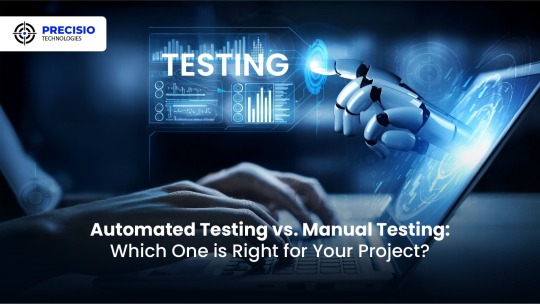
Achieving high-quality, reliable software stands as a fundamental requirement in software development. Successful testing functions as an essential tool to discover faults and build performance capabilities that create better user experience outcomes. Two main testing methods dominate the field: automated testing and manual testing. The process of quality software assurance uses different testing approaches that demonstrate their own advantages as well as weaknesses according to specific project requirements and scenarios. We will explore the specifics to determine which testing process works best for your system development efforts.
1. What Is Manual Testing?

Manual testing involves a human tester manually executing test cases without using automation tools. Key Characteristics:
The methodology focuses its efforts on user interface together with usability and experience testing.
Human-centered applications where selection requires discretion include ad hoc testing and enumerative testing as well as examinations that need human evaluation.
Human performers are required during this approach; thus, it demands substantial time.
2. What Is Automated Testing?
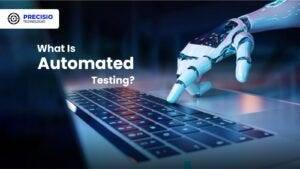
Software performing automated testing executes test cases through workflows and helpers. Key Characteristics:
Efficient for repetitive and regression testing.
Users must spend money on tools along with developing custom scripts for testing.
Reduces human error.
3. Advantages of Manual Testing

Human Intuition: Software testing professionals can detect kernels through their human cognitive ability that automated tools cannot match. The observation and evaluation of visual elements runs more efficiently through human operatives instead of advanced tools.
Flexibility: This method suits exploratory testing specifically because there are no pre-determined scripts available.
Low Initial Investment: Running this approach does not need tool purchases or applications to develop automation frameworks.
Adaptable for UI/UX Testing: Running this approach does not need tool purchases or applications to develop automation frameworks.
4. Advantages of Automated Testing
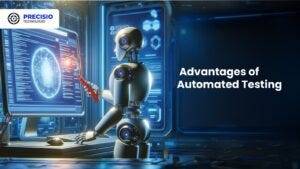
Speed: Executes repetitive tests much faster than humans.
Scalability: The system proves most effective for extensive projects that need constant system updates.
Accuracy: When performing recurring actions, automated systems minimize the chances of human mistakes.
Cost-Efficient in the Long Run: Once established and implemented, the system demands costly investments but ensures continuous development expenses decrease over time.
Better for CI/CD Pipelines: Such testing technology connects various development pipelines that support agile and DevOps methodologies.
5. Disadvantages of Manual Testing

Time-Consuming: The manual performance of repeated tests leads to delayed completion of projects.
Error-Prone: Large applications contain tiny bugs that human testers commonly fail to detect.
Not Ideal for Scalability: The process of increasing manual testing needs additional testers to avoid cost escalations.
6. Disadvantages of Automated Testing
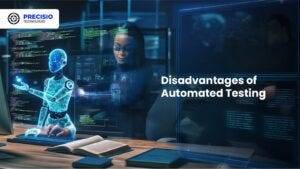
Initial Costs: Organizations must provide high financial resources to procure testing tools together with developing programming constructs.
Limited to Pre-Defined Scenarios: These testing approaches work poorly for handling exploratory or ad hoc testing.
Requires Maintenance: Test scripts need frequent updates when application changes occur.
Not Suitable for UI/UX Testing: Struggles with subjective user experience evaluations.
7. When to Use Manual Testing

Small Projects: The testing method proves beneficial at a low cost for small applications and provides quick assessments.
Exploratory Testing: Testing this approach benefits projects whose scripts have not been defined yet or need evaluation for newly added features.
Visual and Usability Testing: Performing assessments on interface components together with design features.
8. When to Use Automated Testing

Large Projects: Handles scalability for projects with frequent updates.
Regression Testing: Program testing becomes more efficient through automation since automated assessments perform multiple tests following each update process.
Performance Testing: The system performs efficient capabilities to conduct load testing and stress testing.
Continuous Development Environments: Agile progression and DevOps implementations need automation as a core requirement.
READ MORE- https://www.precisio.tech/automated-testing-vs-manual-testing-which-one-is-right-for-your-project/
2 notes
·
View notes
Text
How-To IT
Topic: Core areas of IT
1. Hardware
• Computers (Desktops, Laptops, Workstations)
• Servers and Data Centers
• Networking Devices (Routers, Switches, Modems)
• Storage Devices (HDDs, SSDs, NAS)
• Peripheral Devices (Printers, Scanners, Monitors)
2. Software
• Operating Systems (Windows, Linux, macOS)
• Application Software (Office Suites, ERP, CRM)
• Development Software (IDEs, Code Libraries, APIs)
• Middleware (Integration Tools)
• Security Software (Antivirus, Firewalls, SIEM)
3. Networking and Telecommunications
• LAN/WAN Infrastructure
• Wireless Networking (Wi-Fi, 5G)
• VPNs (Virtual Private Networks)
• Communication Systems (VoIP, Email Servers)
• Internet Services
4. Data Management
• Databases (SQL, NoSQL)
• Data Warehousing
• Big Data Technologies (Hadoop, Spark)
• Backup and Recovery Systems
• Data Integration Tools
5. Cybersecurity
• Network Security
• Endpoint Protection
• Identity and Access Management (IAM)
• Threat Detection and Incident Response
• Encryption and Data Privacy
6. Software Development
• Front-End Development (UI/UX Design)
• Back-End Development
• DevOps and CI/CD Pipelines
• Mobile App Development
• Cloud-Native Development
7. Cloud Computing
• Infrastructure as a Service (IaaS)
• Platform as a Service (PaaS)
• Software as a Service (SaaS)
• Serverless Computing
• Cloud Storage and Management
8. IT Support and Services
• Help Desk Support
• IT Service Management (ITSM)
• System Administration
• Hardware and Software Troubleshooting
• End-User Training
9. Artificial Intelligence and Machine Learning
• AI Algorithms and Frameworks
• Natural Language Processing (NLP)
• Computer Vision
• Robotics
• Predictive Analytics
10. Business Intelligence and Analytics
• Reporting Tools (Tableau, Power BI)
• Data Visualization
• Business Analytics Platforms
• Predictive Modeling
11. Internet of Things (IoT)
• IoT Devices and Sensors
• IoT Platforms
• Edge Computing
• Smart Systems (Homes, Cities, Vehicles)
12. Enterprise Systems
• Enterprise Resource Planning (ERP)
• Customer Relationship Management (CRM)
• Human Resource Management Systems (HRMS)
• Supply Chain Management Systems
13. IT Governance and Compliance
• ITIL (Information Technology Infrastructure Library)
• COBIT (Control Objectives for Information Technologies)
• ISO/IEC Standards
• Regulatory Compliance (GDPR, HIPAA, SOX)
14. Emerging Technologies
• Blockchain
• Quantum Computing
• Augmented Reality (AR) and Virtual Reality (VR)
• 3D Printing
• Digital Twins
15. IT Project Management
• Agile, Scrum, and Kanban
• Waterfall Methodology
• Resource Allocation
• Risk Management
16. IT Infrastructure
• Data Centers
• Virtualization (VMware, Hyper-V)
• Disaster Recovery Planning
• Load Balancing
17. IT Education and Certifications
• Vendor Certifications (Microsoft, Cisco, AWS)
• Training and Development Programs
• Online Learning Platforms
18. IT Operations and Monitoring
• Performance Monitoring (APM, Network Monitoring)
• IT Asset Management
• Event and Incident Management
19. Software Testing
• Manual Testing: Human testers evaluate software by executing test cases without using automation tools.
• Automated Testing: Use of testing tools (e.g., Selenium, JUnit) to run automated scripts and check software behavior.
• Functional Testing: Validating that the software performs its intended functions.
• Non-Functional Testing: Assessing non-functional aspects such as performance, usability, and security.
• Unit Testing: Testing individual components or units of code for correctness.
• Integration Testing: Ensuring that different modules or systems work together as expected.
• System Testing: Verifying the complete software system’s behavior against requirements.
• Acceptance Testing: Conducting tests to confirm that the software meets business requirements (including UAT - User Acceptance Testing).
• Regression Testing: Ensuring that new changes or features do not negatively affect existing functionalities.
• Performance Testing: Testing software performance under various conditions (load, stress, scalability).
• Security Testing: Identifying vulnerabilities and assessing the software’s ability to protect data.
• Compatibility Testing: Ensuring the software works on different operating systems, browsers, or devices.
• Continuous Testing: Integrating testing into the development lifecycle to provide quick feedback and minimize bugs.
• Test Automation Frameworks: Tools and structures used to automate testing processes (e.g., TestNG, Appium).
19. VoIP (Voice over IP)
VoIP Protocols & Standards
• SIP (Session Initiation Protocol)
• H.323
• RTP (Real-Time Transport Protocol)
• MGCP (Media Gateway Control Protocol)
VoIP Hardware
• IP Phones (Desk Phones, Mobile Clients)
• VoIP Gateways
• Analog Telephone Adapters (ATAs)
• VoIP Servers
• Network Switches/ Routers for VoIP
VoIP Software
• Softphones (e.g., Zoiper, X-Lite)
• PBX (Private Branch Exchange) Systems
• VoIP Management Software
• Call Center Solutions (e.g., Asterisk, 3CX)
VoIP Network Infrastructure
• Quality of Service (QoS) Configuration
• VPNs (Virtual Private Networks) for VoIP
• VoIP Traffic Shaping & Bandwidth Management
• Firewall and Security Configurations for VoIP
• Network Monitoring & Optimization Tools
VoIP Security
• Encryption (SRTP, TLS)
• Authentication and Authorization
• Firewall & Intrusion Detection Systems
• VoIP Fraud DetectionVoIP Providers
• Hosted VoIP Services (e.g., RingCentral, Vonage)
• SIP Trunking Providers
• PBX Hosting & Managed Services
VoIP Quality and Testing
• Call Quality Monitoring
• Latency, Jitter, and Packet Loss Testing
• VoIP Performance Metrics and Reporting Tools
• User Acceptance Testing (UAT) for VoIP Systems
Integration with Other Systems
• CRM Integration (e.g., Salesforce with VoIP)
• Unified Communications (UC) Solutions
• Contact Center Integration
• Email, Chat, and Video Communication Integration
2 notes
·
View notes
Text
🌐 Top 10 Tools Every Web Developer Should Know in 2024 🚀
Hey, guys👋 If you're diving into the world of web development or looking to level up your skills, here are the top 10 tools you need to check out this year:
Visual Studio Code - The ultimate code editor with tons of extensions to boost your productivity. 💻✨
GitHub - Manage your code and collaborate with others seamlessly. 🛠️🤝
Bootstrap - Design responsive websites quickly with this popular CSS framework. 📱🎨
Figma - Collaborate on UI/UX designs in real-time with this powerful design tool. 🖌️👥
Node.js - Build scalable server-side applications using JavaScript. 🌐🔧
Webpack - Optimize your JavaScript files and manage dependencies efficiently. ⚙️📦
React.js - Create interactive UIs with this widely-used JavaScript library. ⚛️🔍
Sass - Write more maintainable CSS with features like variables and mixins. 🧩📝
Postman - Test APIs and ensure everything runs smoothly. 🔍💡
Jira - Track tasks and manage agile workflows for smooth project management. 📊📅
These tools can supercharge your development process and help you build amazing web applications. For those looking to take their projects to the next level, partnering with a web application development agency could be the key to unlocking even more potential. 🚀💼
#WebDevelopment#Coding#DeveloperTools#VisualStudioCode#GitHub#Bootstrap#Figma#NodeJS#Webpack#ReactJS#Sass#Postman#Jira#TechTips#WebApplicationDevelopment
3 notes
·
View notes
Text
Are you looking For the Best App Development services in India?

Today, let's delve into the world of custom app development services and the transformative technologies driving innovation in this space. Whether you're a business owner seeking to enhance your digital presence or a developer passionate about crafting unique solutions, understanding the capabilities of various technologies is essential. In this discussion, let's explore how custom app development services leverage Flutter, Native, Android, and iOS technologies to deliver tailored solutions for diverse needs.
Flutter: We are able to develop such hybrid applications that have faster development and increased time-to-market speed. Our developers are ready to serve flexible, materialistic, suitable for all target platforms, compatible with Android, iPhone, and web platforms, and UX and UI technology-based apps.
Native Development: We intend to develop cross platform applications that natively interact between the Android and IOS platforms. Our team is dedicated to developing reliable apps with minimal complexity, using Agile methodologies, paying close attention to app UI design, and allowing for easy app migration.
Android: We intend to offer such Android applications that call for plenty of downloads. Our Android developers always think creatively to provide something exceedingly splendid with each client project.
IOS: We are skilled to deliver next-generation iPhone apps that rank at the top of the App Store. Our iOS developers are dedicated to developing extremely scalable, better customer experiences, faster, more assured, and most engaging iPhone apps.
Custom app development services play a vital role in helping businesses navigate the ever-evolving digital landscape. By harnessing technologies like Flutter, Native, Android, and iOS, custom app development services empower businesses to realize their vision and stay ahead of the competition. Whether it's creating cross-platform experiences with Flutter or delivering platform-specific solutions with native development, custom app development services are poised to drive innovation and deliver value to their clients.
Now, I'm eager to hear from you! What are your thoughts on custom app development services and the technologies they employ? Share your experiences, insights, and aspirations, and let's spark a vibrant discussion on the future of custom app development.
If you want to know more Information Visit this link:
https://www.leewaysoftech.com/mobile-app-dev
#app development#best app development company#flutter app development#ios app development#react native#android app development
3 notes
·
View notes
Text
0 notes
Text
Navigating the Full Stack: A Holistic Approach to Web Development Mastery
Introduction: In the ever-evolving world of web development, full stack developers are the architects behind the seamless integration of frontend and backend technologies. Excelling in both realms is essential for creating dynamic, user-centric web applications. In this comprehensive exploration, we'll embark on a journey through the multifaceted landscape of full stack development, uncovering the intricacies of crafting compelling user interfaces and managing robust backend systems.

Frontend Development: Crafting Engaging User Experiences
1. Markup and Styling Mastery:
HTML (Hypertext Markup Language): Serves as the foundation for structuring web content, providing the framework for user interaction.
CSS (Cascading Style Sheets): Dictates the visual presentation of HTML elements, enhancing the aesthetic appeal and usability of web interfaces.
2. Dynamic Scripting Languages:
JavaScript: Empowers frontend developers to add interactivity and responsiveness to web applications, facilitating seamless user experiences.
Frontend Frameworks and Libraries: Harness the power of frameworks like React, Angular, or Vue.js to streamline development and enhance code maintainability.
3. Responsive Design Principles:
Ensure web applications are accessible and user-friendly across various devices and screen sizes.
Implement responsive design techniques to adapt layout and content dynamically, optimizing user experiences for all users.
4. User-Centric Design Practices:
Employ UX design methodologies to create intuitive interfaces that prioritize user needs and preferences.
Conduct usability testing and gather feedback to refine interface designs and enhance overall user satisfaction.

Backend Development: Managing Data and Logic
1. Server-side Proficiency:
Backend Programming Languages: Utilize languages like Node.js, Python, Ruby, or Java to implement server-side logic and handle client requests.
Server Frameworks and Tools: Leverage frameworks such as Express.js, Django, or Ruby on Rails to expedite backend development and ensure scalability.
2. Effective Database Management:
Relational and Non-relational Databases: Employ databases like MySQL, PostgreSQL, MongoDB, or Firebase to store and manage structured and unstructured data efficiently.
API Development: Design and implement RESTful or GraphQL APIs to facilitate communication between the frontend and backend components of web applications.
3. Security and Performance Optimization:
Implement robust security measures to safeguard user data and protect against common vulnerabilities.
Optimize backend performance through techniques such as caching, query optimization, and load balancing, ensuring optimal application responsiveness.
Full Stack Development: Harmonizing Frontend and Backend
1. Seamless Integration of Technologies:
Cultivate expertise in both frontend and backend technologies to facilitate seamless communication and collaboration across the development stack.
Bridge the gap between user interface design and backend functionality to deliver cohesive and impactful web experiences.
2. Agile Project Management and Collaboration:
Collaborate effectively with cross-functional teams, including designers, product managers, and fellow developers, to plan, execute, and deploy web projects.
Utilize agile methodologies and version control systems like Git to streamline collaboration and track project progress efficiently.
3. Lifelong Learning and Adaptation:
Embrace a growth mindset and prioritize continuous learning to stay abreast of emerging technologies and industry best practices.
Engage with online communities, attend workshops, and pursue ongoing education opportunities to expand skill sets and remain competitive in the evolving field of web development.
Conclusion: Mastering full stack development requires a multifaceted skill set encompassing frontend design principles, backend architecture, and effective collaboration. By embracing a holistic approach to web development, full stack developers can craft immersive user experiences, optimize backend functionality, and navigate the complexities of modern web development with confidence and proficiency.
#full stack developer#education#information#full stack web development#front end development#frameworks#web development#backend#full stack developer course#technology
2 notes
·
View notes
Text
ott development companies in india
ott development companies in india

India stands as a thriving hub for the entertainment industry, witnessing an explosive growth in Over-the-Top (OTT) platforms. With the surge in digital content consumption, the demand for proficient OTT development companies in India has soared. These companies serve as the architects behind the creation of robust, feature-rich, and user-friendly platforms that cater to diverse content preferences of audiences across the globe.
The landscape of OTT development companies in India is characterized by a blend of technical expertise, innovation, and a deep understanding of consumer behavior. These companies leverage cutting-edge technologies and industry best practices to design and develop OTT platforms that offer seamless content streaming experiences across multiple devices.
A hallmark of these companies is their capability to provide end-to-end solutions, encompassing every stage of the development process. From conceptualization and architecture planning to UI/UX design, backend development, integration of content management systems (CMS), analytics, monetization models, and ongoing maintenance, they ensure a comprehensive and robust platform.
Technical proficiency is a cornerstone of these companies. They harness cloud-based infrastructure, advanced video streaming protocols, content delivery networks (CDNs), and stringent security measures to guarantee high-quality video playback, minimal buffering, and secure content delivery. Additionally, they prioritize scalability and adaptability, ensuring that platforms can handle varying user loads and device types without compromising performance.
User experience (UX) and user interface (UI) design are paramount for OTT development companies in India. They focus on creating intuitive interfaces, personalized content recommendations, smooth navigation, and engaging viewing experiences. These efforts are aimed at enhancing user satisfaction, retention, and ultimately, the platform's success.
Furthermore, these companies recognize the significance of analytics and data-driven insights. They integrate analytics tools to gather user behavior data, allowing content providers to understand audience preferences, optimize content libraries, and tailor marketing strategies for better engagement and monetization.
Collaboration and client-centricity define the working ethos of these companies. They collaborate closely with content creators, production houses, broadcasters, and media companies, understanding their unique requirements, content strategies, and target audiences to develop tailor-made solutions aligned with their objectives.
Indian OTT development companies offer versatility in their services, catering to a wide spectrum of requirements. They deliver solutions for video-on-demand (VOD), live streaming, subscription-based models, advertisement integration, multi-device compatibility, and more. This adaptability allows them to meet the diverse needs of clients operating in various niches within the entertainment industry.
As the Indian OTT market continues to expand and evolve, these companies are at the forefront of innovation, driving the industry's growth. Their agility in adopting emerging technologies, responsiveness to market trends, and commitment to delivering high-quality, immersive digital experiences contribute significantly to shaping the future of entertainment consumption globally.
2 notes
·
View notes
Text
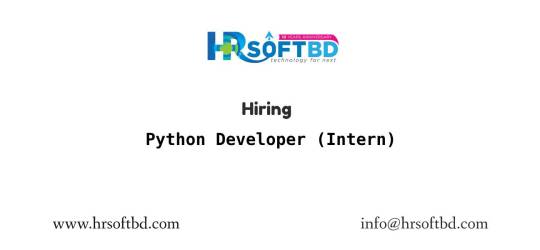
HRsoftBD (https://hrsoftbd.com) is a Website, Software and App Development Company based in Dhaka. We are looking for a Python Developer (Intern) to join our dynamic team. As a Python Developer (Intern), you will be responsible for design & developing high-quality desktop-based applications for cross platforms. The ideal candidate should have a very good knowledge in Python, Desktop Libraries like Tkinter, and SQLite (or similar).
Mail your CV at: [email protected]
Title Should be: Apply for Python Developer (Intern)
Direct Apply from: http://hrsoftbd.com/site/job-apply
Last Date of Application: 15 November 2023
What you’ll do:
Write quality code using Python.
Design desktop UI/UX using Python.
Very good knowledge of Object Oriented.
Work on agile-scrum project teams to deliver software features and enhancements.
SQLite/MySQL Database Maintain and CRUD.
Write clean code as part of a team of software developers
Create acceptance tests for all the code created
Create, review, and update technical documentation
Knowledge on RESTAPI.
You Have:
Minimum Bachelor’s degree in CSE/SE/CS/IT
Knowledge of Python, Object Oriented, SQLite, For Python Desktop any library/framework.
Thorough understanding of MySQL/SQLite
Good behave and communication style
Employment Status
Full-time
Experience Requirements
No experience is required.
Salary
Negotiable
Compensation & other benefits
Yearly 2 bonus (Eid-ul-adha and Eid-ul-fitr)
Weekly 1 Holidays and 1 Half-days
Salary Review: Yearly or Semiannual.
Provident fund (10% extra)
If interested please send your resume at: [email protected]. Title Should be: Apply for Python Developer (Intern).
Wish you all the Best.
HRsoftBD
3 notes
·
View notes